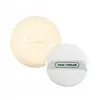What's inside
What's inside
 Key Ingredients
Key Ingredients

 Benefits
Benefits

 Concerns
Concerns

No concerns
 Ingredients Side-by-side
Ingredients Side-by-side

Silica
AbrasiveZinc Oxide
Cosmetic ColorantBis-Hydroxyethoxypropyl Dimethicone
EmollientAluminum Starch Octenylsuccinate
AbsorbentSynthetic Fluorphlogopite
Triethoxycaprylylsilane
Glyceryl Caprylate
EmollientCaprylyl Glycol
EmollientCI 77492
Cosmetic ColorantWater
Skin ConditioningCentella Asiatica Extract
CleansingTocopherol
AntioxidantNiacinamide
Smoothing1,2-Hexanediol
Skin ConditioningSodium Hyaluronate
HumectantGlycerin
HumectantButylene Glycol
HumectantCitrus Junos Seed Extract
AntioxidantHippophae Rhamnoides Fruit Extract
Skin ConditioningAscorbic Acid
AntioxidantMadecassoside
AntioxidantAsiatic Acid
Skin ConditioningAsiaticoside
AntioxidantPropolis Extract
Skin ConditioningMadecassic Acid
Skin ConditioningSilica, Zinc Oxide, Bis-Hydroxyethoxypropyl Dimethicone, Aluminum Starch Octenylsuccinate, Synthetic Fluorphlogopite, Triethoxycaprylylsilane, Glyceryl Caprylate, Caprylyl Glycol, CI 77492, Water, Centella Asiatica Extract, Tocopherol, Niacinamide, 1,2-Hexanediol, Sodium Hyaluronate, Glycerin, Butylene Glycol, Citrus Junos Seed Extract, Hippophae Rhamnoides Fruit Extract, Ascorbic Acid, Madecassoside, Asiatic Acid, Asiaticoside, Propolis Extract, Madecassic Acid
Ingredients Explained
These ingredients are found in both products.
Ingredients higher up in an ingredient list are typically present in a larger amount.
Caprylyl Glycol is a humectant and emollient, meaning it attracts and preserves moisture.
It is a common ingredient in many products, especially those designed to hydrate skin. The primary benefits are retaining moisture, skin softening, and promoting a healthy skin barrier.
Though Caprylyl Glycol is an alcohol derived from fatty acids, it is not the kind that can dry out skin.
This ingredient is also used as a preservative to extend the life of products. It has slight antimicrobial properties.
Learn more about Caprylyl GlycolGlycerin is already naturally found in your skin. It helps moisturize and protect your skin.
A study from 2016 found glycerin to be more effective as a humectant than AHAs and hyaluronic acid.
As a humectant, it helps the skin stay hydrated by pulling moisture to your skin. The low molecular weight of glycerin allows it to pull moisture into the deeper layers of your skin.
Hydrated skin improves your skin barrier; Your skin barrier helps protect against irritants and bacteria.
Glycerin has also been found to have antimicrobial and antiviral properties. Due to these properties, glycerin is often used in wound and burn treatments.
In cosmetics, glycerin is usually derived from plants such as soybean or palm. However, it can also be sourced from animals, such as tallow or animal fat.
This ingredient is organic, colorless, odorless, and non-toxic.
Glycerin is the name for this ingredient in American English. British English uses Glycerol/Glycerine.
Learn more about GlycerinSodium Hyaluronate is hyaluronic acid's salt form. It is commonly derived from the sodium salt of hyaluronic acid.
Like hyaluronic acid, it is great at holding water and acts as a humectant. This makes it a great skin hydrating ingredient.
Sodium Hyaluronate is naturally occurring in our bodies and is mostly found in eye fluid and joints.
These are some other common types of Hyaluronic Acid:
Learn more about Sodium HyaluronateSynthetic Fluorphlogopite is the synthethic version of mica. It consists of fluorine, aluminum and silicate.
Synthetic Fluorphlogopite is used to add volume to products.
It is considered non-irritating on the skin.
Learn more about Synthetic Fluorphlogopite